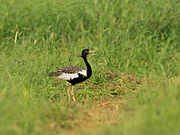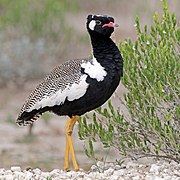Bustard
| Bustards | |
|---|---|

| |
| Kori bustard | |
| Scientific classification | |
| Domain: | Eukaryota |
| Kingdom: | Animalia |
| Phylum: | Chordata |
| Class: | Aves |
| Clade: | Otidimorphae |
| Order: | Otidiformes Wagler,1830 |
| Family: | Otididae Rafinesque,1815 |
| Genera | |
| Synonyms | |
| |
Bustards,includingfloricansandkorhaans,are large,terrestrialbirdsliving mainly indry grasslandareas and instepperegions. They range in length from 40 to 150 cm (16 to 59 in). They make up thefamilyOtididae(/oʊˈtɪdɪdiː/,formerly known asOtidae).[1]
Bustards areomnivorousand opportunistic, eating leaves, buds, seeds, fruit, smallvertebrates,andinvertebrates.[2]There are 26 species currently recognised.
Etymology
[edit]The wordbustardcomes from the Old Frenchbistardaand some other languages:abetarda(pt),abetarda(gl),avutarda(es) used for thegreat bustard.The naturalistWilliam Turnerlisted the English spelling "bustard" and "bistard" in 1544.[3][4]
All of the common names above are derived fromLatinavis tardaoraves tardasgiven byPliny the Elder,[5][a]these names were mentioned by thePierre Belonin 1555 andUlisse Aldrovandiin 1600.[6][7]The wordtardacomes fromtardusinLatinmeaning "slow" and "deliberate",[8]which is apt to describe the typical walking style of the species.[9]
Floricans
[edit]Some Indian bustards are also called floricans. The origin of the name is unclear.Thomas C. Jerdonwrites inThe Birds of India(1862)
I have not been able to trace the origin of the Anglo-Indian wordFlorikin,but was once informed that the Little Bustard in Europe was sometimes called Flanderkin. Latham gives the wordFlercheras an English name, and this, apparently, has the same origin as Florikin.
— Jerdon'sBirds of India,2nd ed. ii. 625.
TheHobson-Jobsondictionary, however, casts doubt on this theory stating that
We doubt if Jerdon has here understood Latham correctly. What Latham writes is, in describing the Passarage Bustard, which, he says, is the size of the Little Bustard:Inhabits India. Called Passarage Plover.... I find that it is known in India by the name of Oorail; by some of the English called Flercher.(Suppt. to Gen. Synopsis of Birds, 1787, 229). Here we understandthe Englishto be the English in India, and Flercher to be a clerical error for some form offloriken.
Taxonomy
[edit]The family Otididae was introduced (as Otidia) by the FrenchpolymathConstantine Samuel Rafinesquein 1815.[10][11][12]Otididaeand before thatOtidaecome from the genusOtisgiven to thegreat bustardby the Swedish naturalistCarl Linnaeusin thetenth editionof hisSystema Naturaein 1758,[13]it comes from the Greek wordὠτίςōtis.[14][15]
| Phylogeny of Otididae[16] | ||||||||||||||||||||||||||||||||||||||||||||||||||||||||||||||||||||||||||||||||||||||||||||||||||||||||||||||||||||||||||||||||||||||||||||||||
|
Family Otididae[17][citation needed]
| Image | Genus | Living species |
|---|---|---|

|
LissotisReichenbach 1848 |
|

|
NeotisSharpe 1893 |
|

|
ArdeotisLe Maout 1853 |
|

|
TetraxForster 1817 |
|

|
OtisLinnaeus 1758 |
|

|
ChlamydotisLesson 1839 |
|

|
HoubaropsisSharpe 1893 |
|

|
SypheotidesLesson 1839 |
|

|
LophotisReichenbach 1848 |
|

|
HeterotetraxSharpe 1894 |
|

|
EupodotisLesson 1839 |
|

|
AfrotisGray 1855 |
|
- Extinct genera
- Genus †GryzajaZubareva 1939
- †Gryzaja odessanaZubareva 1939
- Genus †IoriotisBurchak-Abramovich & Vekua 1981
- †Ioriotis gabuniiBurchak-Abramovich & Vekua 1981
- Genus †MiootisUmanskaya 1979
- †Miootis compactusUmanskaya 1979
- Genus †PleotisHou 1982
- †Pleotis liuiHou 1982
Description
[edit]Bustards are all fairly large with the two largestspecies,thekori bustard(Ardeotis kori) and thegreat bustard(Otis tarda), being frequently cited as the world's heaviest flying birds. In both the largest species, large males exceed a weight of 20 kg (44 lb), weigh around 13.5 kg (30 lb) on average and can attain a total length of 150 cm (59 in). The smallest species is thelittle brown bustard(Eupodotis humilis), which is around 40 cm (16 in) long and weighs around 600 g (1.3 lb) on average. In most bustards, males are substantially larger than females, often about 30% longer and sometimes more than twice the weight. They are among the mostsexually dimorphicgroups of birds. In only thefloricansis the sexual dimorphism the reverse, with the adult female being slightly larger and heavier than the male.[citation needed]
The wings have 10 primaries and 16–24 secondary feathers. There are 18–20 feathers in the tail. The plumage is predominantly cryptic.[2]
Behaviour and ecology
[edit]Bustards areomnivorous,feeding principally on seeds andinvertebrates.They make their nests on the ground, making their eggs and offspring often very vulnerable to predation. They walk steadily on strong legs and big toes, pecking for food as they go. Most prefer to run or walk over flying. They have long broad wings with "fingered" wingtips, and striking patterns in flight. Many have interesting mating displays, such as inflating throat sacs or elevating elaborate feathered crests. The female lays three to five dark, speckled eggs in a scrape in the ground, and incubates them alone.[19]
Evolution
[edit]Genetic dating indicates that bustards evolvedc.30 million years ago in either southern or eastern Africa from where they dispersed into Eurasia and Australia.[20]
Status and conservation
[edit]
Bustards are gregarious outside the breeding season, but are very wary and difficult to approach in the open habitats they prefer.[21]Most species are declining or endangered through habitat loss and hunting, even where they are nominally protected.
United Kingdom
[edit]The birds were once common and abounded on theSalisbury Plain.They had become rare by 1819 when a large male, surprised by a dog onNewmarket Heath,sold inLeadenhall Marketfor fiveguineas.[22]The last bustard inBritaindied in approximately 1832, but the bird is being reintroduced through batches of chicks imported from Russia.[21]In 2009, twogreat bustardchicks were hatched in Britain for the first time in more than 170 years.[23]Reintroduced bustards also hatched chicks in 2010.[24]
Notes
[edit]- ^"proximae iis sunt quas Hispania aves tardas appellat, Graecia ωτιδος damnatas in cibis; emissa enim ossibus medulla odoris taedium extemplo sequitur." [Next to these are the birds that Spain callstardaeand Greeceotides,which are condemned as an article of diet, because when the marrow is drained out of their bones a disgusting smell at once follows.][5]
References
[edit]- ^Gill, Frank;Donsker, David;Rasmussen, Pamela,eds. (2019)."Turacos, bustards, cuckoos, mesites, sandgrouse".World Bird List Version 9.2.International Ornithologists' Union.Retrieved26 June2019.
- ^abdel Hoyo, J. Elliott, A. & Sargatal, J. (editors). (1996)Handbook of the Birds of the World. Volume 3: Hoatzin to Auks.Lynx Edicions.ISBN84-87334-20-2
- ^Turner, William(1903) [1544].Turner on birds: a short and succinct history of the principal birds noticed by Pliny and Aristotle first published by Doctor William Turner, 1544(in Latin and English). Translated byEvans, A.H.Cambridge: Cambridge University Press. pp. xvi, 130–131.
- ^Turner, William(1544).Avium praecipuarum, quarum apud Plinium et Aristotelem mentio est, brevis et succincta historia(in Latin). Cambridge: Ioan. Gymnicus. pp. 72–73.
- ^abPliny Natural History III Libri VIII-XI.The Loeb Classical Library. Translated by Rachham, H. Cambridge, Massachusetts: Harvard University Press. 1967. pp. 328–329.
- ^Belon, Pierre(1555).L'histoire de la natvre des oyseavx: avec levrs descriptions, & naïfs portraicts retirez du natvrel, escrite en sept livres(in French). Paris: Gilles Corrozet. pp. 235–237.
- ^Aldrovandi, Ulisse(1637) [1600].Vlyssis Aldrovandi philosophi ac medici Bononiensis historiam naturalem in gymnasio Bononiensi profitentis, Ornithologiae(in Latin). Vol. 2. Bononiae (Bologna, Italy): Apud Nicolaum Tebaldinum. p. 85.
- ^Lewis, Charlton T.; Short, Charles (1879)."tardus".A Latin Dictionary.Perseus Digital Library.
- ^"Great Bustard (Otis tarda) – Information on Great Bustard".Encyclopedia of Life.Retrieved21 August2012.
- ^Rafinesque, Constantine Samuel(1815).Analyse de la nature ou, Tableau de l'univers et des corps organisés(in French). Vol. 1815. Palermo: Self-published. p. 70.
- ^Bock, Walter J. (1994).History and Nomenclature of Avian Family-Group Names.Bulletin of the American Museum of Natural History. Vol. 222. New York: American Museum of Natural History. pp. 137, 252.hdl:2246/830.
- ^"Taxonomic lists- Aves".Retrieved30 December2015.
- ^Linnaeus, Carl(1758).Systema Naturae per regna tria naturae, secundum classes, ordines, genera, species, cum characteribus, differentiis, synonymis, locis(in Latin). Vol. 1 (10th ed.). Holmiae (Stockholm): Laurentii Salvii. p. 154.
- ^Jobling, James A. (2010).Helm Dictionary of Scientific Bird Names.London, UK:Christopher Helm.p. 286.ISBN978-1-4081-3326-2.OCLC659731768.
- ^Liddell, Henry George; Scott, Robert (1940)."ὠτίς".A Greek-English Lexicon.Perseus Digital Library.
- ^Boyd, John (2007)."Otididae"(PDF).John Boyd's website.Retrieved30 December2015.
- ^"Turacos, bustards, cuckoos, mesites, sandgrouse".IOC World Bird List.v13.2.Retrieved21 October2023.
- ^MacQueen's bustard has recently been split from the houbara bustard as a full species.
- ^Archibald, George W. (1991). Forshaw, Joseph (ed.).Encyclopaedia of Animals: Birds.London: Merehurst Press. pp. 98–99.ISBN978-1-85391-186-6.
- ^Pitra, C.; Lieckfeldt, D.; Frahnert, S.; Fickel, J. (2002). "Phylogenetic relationships and ancestral areas of the bustards (Gruiformes: Otididae), inferred from mitochondrial DNA and nuclear intron sequences".Molecular Phylogenetics and Evolution.23(1): 63–74.doi:10.1006/mpev.2001.1078.PMID12182403.
- ^abBota, G., J. Camprodon, S. Mañosa & M.B. Morales (Editores). (2005). Ecology and Conservation of steppe-land birds. Lynx Editions. BarcelonaISBN84-87334-99-7;978-84-87334-99-3.
- ^The National Cyclopaedia of Useful Knowledge, Vol.III,London, (1847) Charles Knight, p.963
- ^Bird Guides 2009.The first Great Bustard chicks in the UKBird Guides, June 2009.
- ^Biodiversity Lab 2010.Reintroduced Great Bustards Breed AgainArchived2017-01-25 at theWayback MachineThe Biodiversity Lab, University of Bath.
Bibliography
[edit]- Bota, Gerard, et al.Ecology and Conservation of Steppe-Land Birds.International Symposium on Ecology and Conservation of Steppe-land birds.Lynx Edicions 2005.343 pages.ISBN84-87334-99-7.
- Chisholm, Hugh,ed. (1911)..Encyclopædia Britannica(11th ed.). Cambridge University Press.
- Knox, Alan G.; Martin Collinson; Andreas J. Helbig; David T. Parkin; George Sangster (October 2002)."Taxonomic recommendations for British birds".Ibis.144(4): 707–710.doi:10.1046/j.1474-919X.2002.00110.x.
- Sibley, Charles G.; Jon E. Ahlquist (1990).Phylogeny and Classification of the Birds: A Study in Molecular Evolution.New Haven: Yale University Press.ISBN978-0-300-04085-2.
- Hackett, SJ; et al. (2008). "A phylogenomic study of birds reveals their evolutionary history".Science.320(5884): 1763–1768.Bibcode:2008Sci...320.1763H.doi:10.1126/science.1157704.PMID18583609.S2CID6472805.
- Jarvis, Erich D; et al. (2014)."Whole-genome analyses resolve early branches in the tree of life of modern birds".Science.346(6215): 1320–1331.Bibcode:2014Sci...346.1320J.doi:10.1126/science.1253451.PMC4405904.PMID25504713.
External links
[edit]- Bustard videoson the Internet Bird Collection
